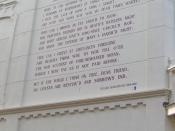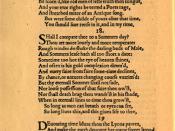William Shakespeare is known for his ability to use literature, and to use his words in a way many meanings can be drawn. Because of the beauty of his work and many interpretations of his literature, he has stood the test of time. William Shakespeare simultaneously used tone, word choice, and structure to make each sonnet unique.
All of Shakespeare's sonnets are coordinated to have fourteen lines divided into three quatrains and one couplet. The quatrains are usually different ideas with separate tones and a couplet at the end of the sonnet binding the three quatrains together. However Sonnet 138 is slightly different because its first two quatrains are the same in tone. The first quatrain and second quatrains tell the reader of each lover's dishonestly to the other. The third quatrain is where the tone begins to change. Shakespeare uses rhyme in the sonnet so that it can be read in a more comprehensive and fluid way.
The sonnet is devised in ABAB format to give the poem a better sound when read aloud.
Shakespeare's work has been famous for many reasons and will continue to be great, but the way he uses words may be what he most famous for. In Sonnet 138, he used word plays, paradoxes, and metaphors to give depth to the meaning of the poem. There are so many different possibilities for interpretation of the same poem that many individuals will use their imaginations and take what they want from it.
Shakespeare's Sonnet 138
Then my love swears that she is made of truth
I do believe her, though I know she lies,
That she might think me some untutor'd youth,
Unlearned in the world's false subtleties.
Thus vainly thinking that she thinks me young,
Although she knows my days are past the best,


